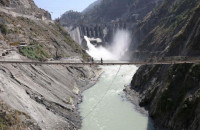Pakistani Brazuca has better aerodynamics than Jabulani: NASA
Brazuca uses a groundbreaking six-panel design, which improves symmetry, uniformity and efficiency.

The Brazuca consists of six panels all covered in tiny bumps and was produced after two and a half years of testing. Adidas also shifted manufacturing of the ball to Pakistan. PHOTO: AFP/FILE
Players complained the official Jabulani ball from four years ago was too unpredictable - a result of the almost perfectly smooth design, which meant that the airflow over the ball pulled it in unpredictable directions.
Although some strikers were able to take advantage of the trait, the erratic trajectory drew complaints from goalkeepers who had trouble gauging where to block.
With memories of 2010 still fresh, Adidas - which designed and manufactured both balls - worked to create a more predictable piece of sports equipment this time around with the ball being produced in Pakistan.
"Adidas spent two and a half years developing and refining the ball, making it the most tested ball we have ever created," the company wrote in a product description posted on the FIFA website, where the balls sell for $160 each.
"The Brazuca uses a groundbreaking six-panel design, which improves symmetry, uniformity and efficiency," it said, adding that the "evolutionary panel shape creates flight speed and enhances roundness."
The seams around the panels are deeper in the Brazuca than in the 2010 ball, NASA said, and the panels are covered in tiny bumps - all designed to direct the airflow around the ball to help it move faster and straighter.
"There is a thin layer of air that forms near the ball's surface called the boundary layer, and it is the state and behavior of that layer that is critical to the performance of the ball," explained Rabi Mehta, chief of the Experimental Aero-Physics Branch at NASA's Ames Research Center in California.
The tiny bumps and deep seams disturb that layer of air, Mehta said, which reduce the low-pressure wake behind a ball that slows it down.
He demonstrated the effect in a wind tunnel in the lab, releasing laser-highlighted smoke over the ball at different wind speeds to demonstrate the flow patterns.
"What we are looking for in the smoke patterns is at what speed the smoke patterns suddenly change," remarked Mehta.
For the 2014 ball, that effect happens at speeds of around 30 miles (48 kilometers) per hour - and is much less noticeable at 50 to 55 miles per hour, the typical kick speed of a World Cup player.
The reverse was true of the 2010 ball, Mehta said.
"The players should be happier with the new ball," he predicted. "It is more stable in flight and will handle more like a traditional 32-panel ball."



















COMMENTS
Comments are moderated and generally will be posted if they are on-topic and not abusive.
For more information, please see our Comments FAQ